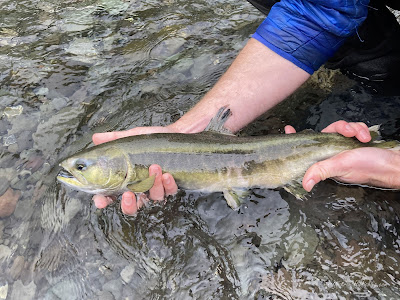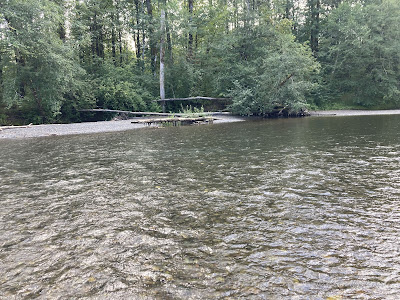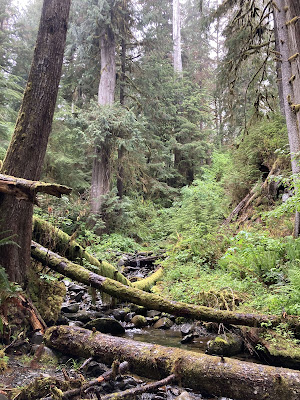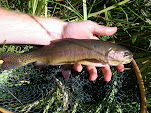Two years ago, I attended a American Fisheries Society (AFS) Conference in Boise Idaho, which had an intriguing talking on the agenda focused on the native trout of the Wood River of central Idaho. I had fished the Wood River and one of its tributaries back in the fall of 2011 and remembered the "Rainbow Trout" I caught having a unique look about them, but didn't think too much of it, as at the time it was thought that any native trout of the basin, which were believed to have been Columbia Basin Redbands had long since been replaced by the hatchery Rainbow Trout. However, the presentation at the AFS conference indicated that the native trout had indeed managed to persist in the Wood River basin, but were far more unique than originally expected.
The Wood River watershed has long been isolated from the rest of the Snake River basin by a series of falls in the Malad Goge and a unique native fish community including an endemic species of sculpin. It turns out that the Redbands of the Basin are quite unique as well and appear originated from an ancestor from outside of the Columbia Basin. It is currently hypothesized that these Redbands may be a hold over from when the Snake River flowed south into Oregon and California, before its course was rerouted into the Columbia watershed and likely represent a new subspecies.
While I was sure that I had already caught this subspecies, I had one major hiccup as I had lost all of my pictures from late 2011 and 2012, when I had a freak computer crash and external hard drive crash within days of each other. It wasn't until this July when the opportunity to revisit the Wood River and fish for these unique Redbands finally arose again.
My wife and I have talked about taking a trip to the Sawtooth Mountains of Idaho for years and with our daughter a bit older now, we deemed that this year was finally the right time. So this trip was a family vacation with my daughter and two nieces first, but I would have a little time to break away and do a little fishing as well, and if I was lucky catch the last Redband I need to document in the US. So in late July we hit the road bound for central Idaho and had a smooth drive to our first stop in Pendleton where we going to spend our first night. However, it seemed that the skies were particularly smoky as we reached Pendleton and when I checked the road conditions for the next day's drive it was clear why. A massive brush fire (the Durkee Fire) had broken out near I-84 and another fire was burning along US 395 and both roads were closed. We went to bed that night with it unclear whether we would even be able to get to Idaho and unfortunately, when we woke up the next morning, the roads were still closed so we opted to grab breakfast before deciding our course of action. Luckily that was all the time it took for I-84 to open and we were one our way again and had a smooth albeit smokey journey to Ketchum Idaho where we would be staying for the next few days.
The next morning was my opportunity to try for some Wood River Redbands and based on the suggestion of my friend Steve MacMillan who had caught some the previous summer, I decided to try my luck on a headwaters tributary stream. I arrived at the stream just as the first pale rays of the morning sun lit the valley and immediately hit the trail headed for the stream armed with my 2WT and an ever dependable Royal PMX and Blowtorch nymph dropper.
 |
| Early morning in the upper Wood River watershed |
 |
| Entering the Hemingway Boulders Wilderness |
Upon hitting the stream the water was icy cold, making me question my sanity for choosing to wet wade, and while I rose a couple of trout in the first two holes that I came to, that was all the activity that saw as the stream was shallow and holding water was sparse. For that first hour, I didn't see any indications of life and I was just starting to question whether I shouldn't just go try another stream when I came to a fork where two tributaries met.
 |
| The stream and its limited hold water |
Of the two forks, the right one looked to be the larger and better of the two streams and would keep me closer to the trail if I need to relocate, so I decided to follow it for a bit before giving up. While the first couple of bends were pretty shallow, it didn't take too long to finally spot some good holding water where the stream made a sharp bend and bet yet spot a few fish holding near the far bank.
 |
| The first good holding water on the right hand tributary |
I made a cast into the main seam and sure enough as my fly drifted into the main holding water, a fish rose to take my dry fly and moments later I had a beautiful deep bodied Wood River Redband in my net.
 |
| My first Wood River Redband of the morning |
Having observed all of the known forms of Redbands in the United State, these fish immediately struck me as unique looking, with a fine speckles, a deep brassy red band and yellowish bronze coloration and are certainly a beautiful native fish.
From that point on, I found plenty of good holding water, but the next fish I encountered was a nonnative Brook Trout instead of a Redband. In recent years, Idaho has liberalized the harvest of Brook Trout to help reduce their densities and I decided that this was a good time to do my part and keep a few Brookies as well.
A few bends upstream of where I caught the Brookie, I found a nice deep pool that looked like ideal habitat and set to work covering the water.
 |
| One of the best pools on the stream |
I didn't take long for a fish to notice my dry fly after a short fight, I brought a slightly larger and heavily spotted Redband that really showed off the distinctiveness of this newly recognized subspecies.
 |
| A beautiful fine spotted Wood River Redband |
This first fish was followed by a Brook Trout and another smaller Redband, but I felt that there really should be another fish in the pool and after a few more casts, I spotted a decent sized fish holding under the bubble curtain towards the tailout. It took a few casts, but finally I watched as the fish moved over to intercept my nymph. I set the hook and the Redband came shooting out of the water, but there was nowhere for the fish to go and after a short battle I brought a beautiful darkly colored male Redband to the net.
 |
| A male Redband still showing some of its spawning colors |
At this point, the morning was wearing on, but I figured that I should have time for a few more bends. I picked up a couple more Brook Trout and Redbands as I worked my way upstream, but before long I came to a stretch where it looked to be a long ways to the next piece of holding water so I decided that it was finally time to catch the trail and make my way back to the car.
 |
| Hiking along the stream on the way out |
The hike back offered beautiful views of the Boulder Mountains and the stream as the trail meandered through patches of forest and meadows on the way back down the valley.
 |
| The Boulder Mountains |
I ended up making much better timing than I had expected on the hike out and as I remembered seeing a nice pool on the drive up earlier that morning so I figured it was worth a stop. It only took a few minutes to hook a fish at this next spot, but when I brought it in it looked quite different from the natives upstream, with different coloration and spotting pattern and was clearly one of the hatchery fish that Idaho continues to stock throughout the Wood River basin. Having caught that hatchery fish, I figured I would be unlikely to find any natives in this stretch, so I finally decided to call it a day.
 |
| A hatchery Rainbow from the lower part of the stream |
After wrapping up fishing, we spent the rest of the day exploring Ketchum and Sun Valley and enjoying the pool where we were staying and had a special treat of fresh Brook Trout with dinner.
 |
| Brook Trout dinner |
The next day we decided to get out and explore the upper Salmon River and check out the some of the ghost towns near Challis. Since I had caught some Redbands the previous morning, I left my fly rod behind so we could just focus on sightseeing and family time. We decided to make a loop of it and drove up Trail Creek Pass into the Big Lost watershed, then into the Salmon River drainage, which made for a stunning drive. We then made our way to the Land of the Yankee Fork Museum just outside of Challis before heading over to the Bayhorse ghost town.
 |
| The Bayhorse ghost town |
Bayhorse was a thriving mining town in the late 1800's built to take advantage of nearby silver, lead and copper deposits. While abandoned now, town once supported 300 residents, but when the mines dried up, the town died with it. Bayhorse is a relatively new addition to the Idaho State Park system, only opening to the public in 2009. Bayhorse is truly spectacular and well worth the visit and it was a ton of fun to share this piece of the old west with my family, although it was hard not to wonder whether the stream running through the valley held a population of native Salmon River Westslope Cutthroat.
 |
| Another view of Bayhorse |
From Bayhorse we drove up the Salmon River Valley to Stanely where lunch, in the shadow of Sawtooth Mountains. These mountains are home to several rare fish both native and not. The rarest of these nonnative fish are the Sunapee Trout, a unique form of Acadian Arctic Char were native to Lake Sunapee in New Hampshire. These char went extinct in their native waters in the 1950’s due to the introduction of nonnative Lake Trout, landlocked Atlantic Salmon and smelt. However, in the 1920’s, these Sunapee Trout were stocked in Sawtooth Lake and a few other waterbodies and it is believed that some have managed to persist there to this day.
The other rare fish are the native Sockeye Salmon historically found in five lakes in the Sawtooth Valley but have only and just barely managed to hold on in Redfish Lake. While I have never been to Redfish Lake, I launched my fisheries career working with captive reared Redfish Sockeye in western Washington and had hoped to finally see Redfish Lake on this trip. Unfortunately, a wildfire broke out along the shores of Redfish Lake just a week before our trip and the area was still closed, so instead we visited one of the other lakes that once held these Sockeye and spent a couple of hours swimming and enjoying the beauty of our surroundings.
 |
| A great day for swimming at one of the Sawtooth Mountain Lakes |
The Lake was gorgeous and I was amazed by all of the trout I could see cruising the shoreline and holding near the docks, and while I didn't have a rod with me it was a joy just to observe them in their natural habitat. After a couple hours an afternoon thunderstorm rolled in a it was time to wrap up our swimming session and head back to Ketchum.
 |
| The Sawtooth Mountains on the drive back |
When it came time to head home, I figured that the fires around I-84 should be under control, but when I checked on road conditions the night before I-84 was once again closed. We already had a place to stay booked in Pendleton, and while the fire situation added a lot of stress to the drive, we did luck out once again, as I-84 opened while we were on our way back. Once we did hit the fire zone it was easy to see why the road had been closed, as the fire had burnt right up to the road as it cut through the aptly named Burnt River valley.
 |
| Burned country as far as the eye could see, the after effects of the Durkee Fire |
This wasn’t the only fire either and as we drove back there was a depressing number of new burn spots and even and active burn in the Columbia Gorge.
 |
| Another fire burning along I-84 in the Columbia Gorge |
Despite the extreme fire conditions and extra stress associated with the road closures, we had a wonderful trip. It also felt great to check my last Redband in the US off my list, especially after wrapping up the Cutthroat last year. I do have a few Cutthroat I want to revisit, but from this point on I am going to have to go much further afield as I seek the document the remaining native salmonids in the US and Canada with all of my remaining species now found either on the east coast or in Alaska..































































